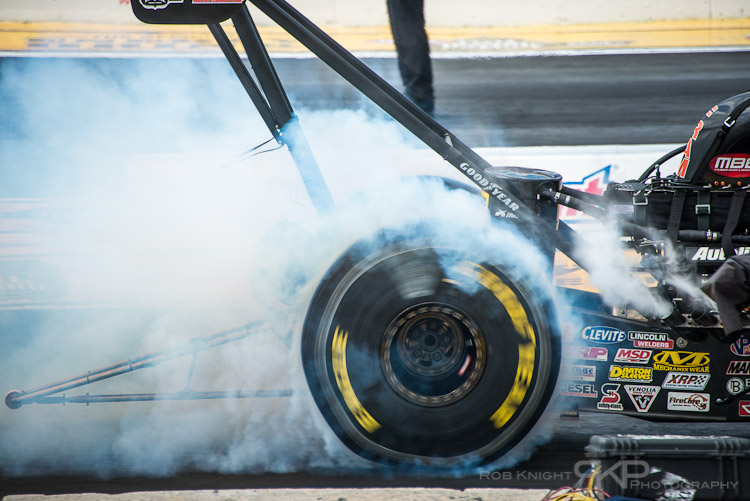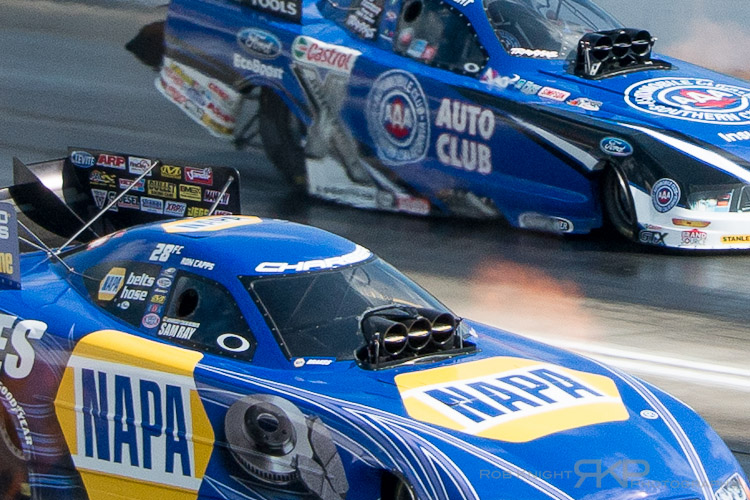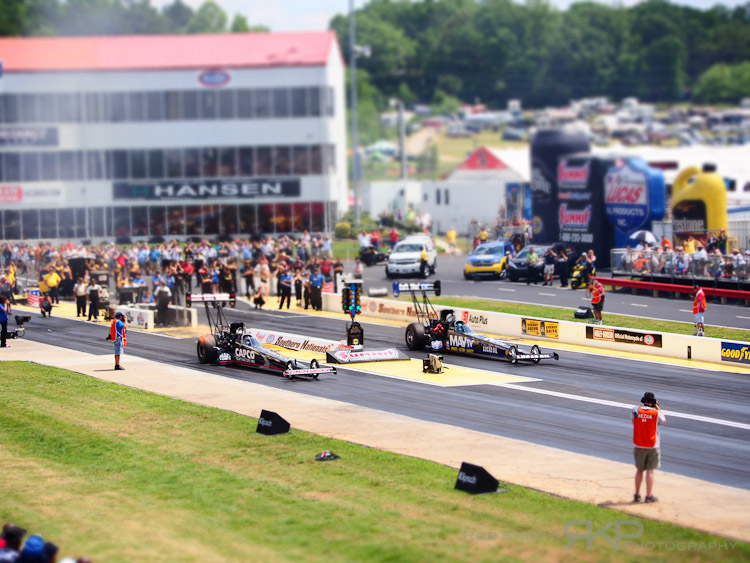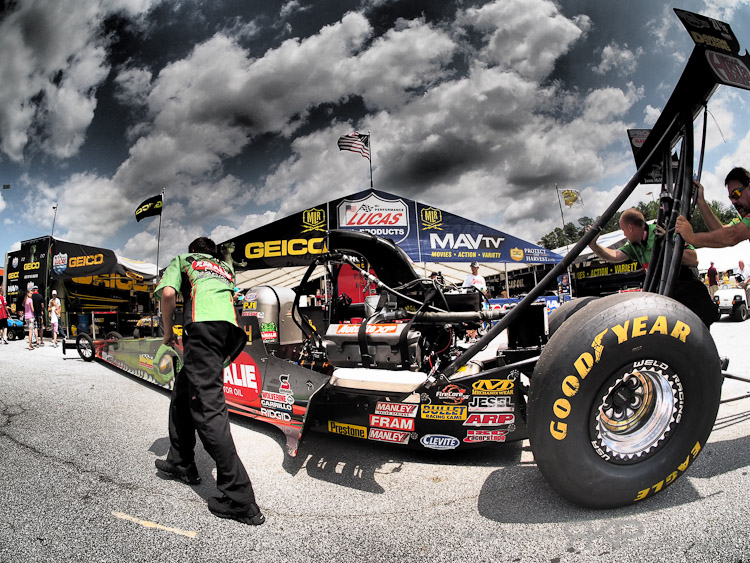I spent the day last Sunday at the NHRA Southern Nationals drag race in Commerce, GA. If you haven’t been to a Top Fuel drag race, you should definitely check it out! There is nothing like two cars going 0-320 mph in less than FOUR SECONDS. The Southern Nationals is a great event for photographers. Of course there are fast cars, smoking tires and flaming headers, but there’s also a lot going on in the pit area. You can get up-close and personal with the crews while they repair and rebuild the huge motors between runs.
I showed up at the race loaded for bear. I would normally only bring one camera and maybe a couple of lenses to an event like this, but I have two new camera bodies that I’m still trying to evaluate. By “evaluate” I mean use the cameras in different situations and determine their respective strengths and weaknesses. In short, they both produce great images. Are there any times I might reach for one system over the other and why? Here are my thoughts.
The Nikon D800Elives up to the hype. It is currently the highest resolution DSLR camera on the market. The 36mp sensor takes advantage of much of the same technology found in the 16mp top-of-the-line Nikon D4 that costs $3k MORE. Nikon’s excellent 51-point AF and surprisingly good metering perform as expected in the D800E. The biggest surprise for me has been the performance at higher ISO settings. There are plenty of websites that offer side-by-side comparisons at different settings, but I’ll simply say that I have no problem with the D800E files at settings up to ISO 3200 or even a bit higher.
Even if you need to reduce noise in post processing, there is so much information in the files that you can easily sharpen the details back to life after blurring them with NR. Speaking of post processing… The dynamic range captured by the D800E is remarkable. I have yet to find a clipped highlight or blocked-up shadow that I couldn’t bring back in Lightroom4. When I first got the D800E I was marveling at how easily and beautifully I brought back a totally clipped blue sky in a landscape image… then I realized I was working on the small jpeg instead of the RAW file!
It’s easy to forget the extreme resolution of the D800E because the controls, AF and ISO performance. I would definitely recommend using Nikon’s best lenses for maximizing the potential of this monster sensor. Although the images in this post were all made with the 28-300mm f/3.5-5.6G VR lens. You would be hard pressed to find a camera and lens combo that would offer this combination of image quality and versatility in such a small package.
And speaking of hype… The Olympus OM-D E-M5 is a hot little number. Unless you pre-ordered an E-M5 when it was first announced you probably don’t have one yet. From what I have read even the preorders have not all been filled. The E-M5 is the latest Micro Four Thirds camera from Olympus, and it is the first in the OM-D series. Their are TONS of reviews of the E-M5 online that all have one thing in common… they all love this camera. I am in complete agreement.
The Olympus PEN E-P3 was my first M4/3 camera. I enjoy it very much, but it is definitely not the camera for every situation. It is OK up to ISO 800, but 1600 gets pretty grainy. The main problem I have with the E-P3 is the dynamic range. Specifically, the underexposed areas in an image (i.e. shadows) lose detail and become quite “mushy”. Much like a point-and-shoot digital camera. Both of these issues make the E-P3 not good for shooting in less than good light.
I have not seen these problems with the E-M5. The high ISO performance is killer, especially for such a relatively small sensor. ISO 1600 is no problem at all for the E-M5. From my experience the dynamic range is greatly improved over the E-P3 as well. I have noticed much more detail in the shadow areas and it seems like there is more highlight headroom as well. There IS noticeably more grain in underexposed parts of an image. These are normally background areas and don’t really pose a problem. The dynamic range is NOT on par with the D800E, but for most shooting situations it is more than adequate. The higher resolution (16mp vs 12mp) shows noticeably more detail than it’s predecessor. With good lenses you could easily use the E-M5 as your only camera, not just as a small “backup” or travel camera. Before last week I had been happiest with Olympus lenses. The Olympus M. Zuiko Digital ED 12mm f/2.0 and the Olympus M. Zuiko Digital ED 45mm f/1.8
are no brainer lenses for any m4/3 kit. The Olympus 12-50mm F3.5-6.3
kit lens with the E-M5 has been a pleasant surprise for me as well. Even though it has a fairly slow maximum aperture, it focuses FAST and makes a nice sharp image. I owned the Panasonic LUMIX G 20mm f/1.7
pancake lens for a while, but the dog-slow AF drove me nuts and I sold it. I recently purchased a Panasonic 45-200mm f/4.0-5.6
zoom and it feels much snappier than the 20mm. This telephoto is a bargain at under $200. The lens is small and sharp and a nice long lens for your m4/3 kit.
So both cameras make great images… what did I learn at the drag strip?
First, the D800E… I have yet to see any moire effects in my D800E files. I was a little bit worried about that when I ordered the specialty “E” version, but I wanted the best possible image quality. I thought for sure that one of the cars, motors, etc at the race would give me moire problems. I didn’t see any trouble at all. The resolution of the D800E is truly remarkable. I liken it to the first time you saw an HD television. It feels more like looking through a window than looking at an image. The high resolution makes it easy to crop if you have to when you’re shooting a race from the cheap seats. The 51point AF had no problem tracking 300mph top fuel dragsters. The only negative that stood out was the speed, or I should say LACK of speed. At 4 frames per second the D800E is not exactly a sports shooting machine. After shooting the D3s the 800 feels like shooting in slow motion.
I have enjoyed shooting the E-M5 since I got it. Excellent image quality, fast AF, small size, etc. There were several times at the drag strip when I looked at my friends and wondered out loud, “why did I bring another camera?”. The E-M5 with two lenses is so light weight you don’t notice the camera bag around your neck. When you get sharp images and that nice “Olympus color” it’s easy to think about leaving the “Pro” gear at home.
The AF tracking in the E-M5 is not in the same league as the Nikon’s. In fact, when you shoot at the maximum 9 frames per second the focus doesn’t track at all. You can shoot in continuous low frame advance and the tracking is OK, but top fuel dragsters were a little bit too fast for it. I got a couple of keepers of the cars screaming by, but the D800E was my go-to body for most of the speedy stuff. I’m going to work with it some more and see if there are some settings I can change to improve the tracking.
I find myself reaching for the Olympus more often than I reach for the Nikon these days when I’m shooting for fun. On the other hand, I always grab the Nikon when I’m shooting for a paying client. If I end up shooting one system all of the time I will consider selling out of the other, but right now I’m very happy with both.
If you’d like to try the Olympus E-M5 you can use one for free during my Costa Rica photo workshop in September. You can bring your current gear and compare, or leave your gear at home and use the Olympus kit all week. Click HERE to get more info and register.






Hi Rob, nice comparison and I find myself inching ever so close to ordering the em-5, having shot with E-510 for the past 5 years now.
Just curious why you reach for the Nikon when shooting for a paying client … is it habit, expectation of the client or just “phobia” of m4/3rd v/s bigger sensors?
Thanks Ken,
I think I use the Nikon for all of the reasons you mention. It looks more “professional”, and I know the files will be better than the client will ever need. I need a bit more experience with the E-M5 before it becomes my go-to camera for every situation. For example, I’m teaching at the BlueRidge Photo Fest this weekend and I will bring both systems. I can’t say that I will definitely use the D800e, but I’m not quite comfortable leaving it at home.
Cheers- Rob
Thanks Rob, that makes sense. When I first looked through the EVF of OM-D, it did make me a tad uncomfortable, having used OVFs all along. It was too bright, almost like the lcd of a compact.
That said, this is definitely my next camera.
Cheers,
Ken
The EVF brightness has not been an issue for me. I haven’t found it to be too bright at all.
Rob
I absolutely love this camera. This is my first DSLR camera, in fact it is pretty easy to use